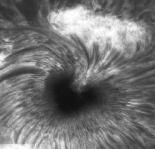Basic Features of Sunspots
 The largest sunspots observed have had diameters of about 50,000 km, which
makes them large enough to be seen with the naked eye. Sunspots often come in
groups with as many as 100 in a group, though sunspot groups with more than
about 10 are relatively rare. There are well established methods for
measuring the
number of sunspots. Here, for example, is a
table giving the daily count of observed sunspots in
the year 1996.
Sunspots develop and persist for periods ranging from hours to months, and are
carried around the surface of the Sun by its rotation (a fact known to Galileo).
The images on this page
show a single sunspot and a complex sunspot group. A typical
sunspot consists of a dark central region called the umbra and somewhat
lighter surrounding region called the penumbra
The largest sunspots observed have had diameters of about 50,000 km, which
makes them large enough to be seen with the naked eye. Sunspots often come in
groups with as many as 100 in a group, though sunspot groups with more than
about 10 are relatively rare. There are well established methods for
measuring the
number of sunspots. Here, for example, is a
table giving the daily count of observed sunspots in
the year 1996.
Sunspots develop and persist for periods ranging from hours to months, and are
carried around the surface of the Sun by its rotation (a fact known to Galileo).
The images on this page
show a single sunspot and a complex sunspot group. A typical
sunspot consists of a dark central region called the umbra and somewhat
lighter surrounding region called the penumbra
| A complex sunspot group. |
The Solar Rotational Period
Because the Sun is not a solid body, it does not have a well defined rotational period. Modern measurements indicate that the rotational period of the Sun is about 25 days near its equator, 28 days at 40 degrees latitude, and 36 days near the poles. The rotation is direct, that is, in the same sense of the motion of the planets around the Sun.
No comments:
Post a Comment
IT'S YOUR TURN...
To respond : Drop in just anything but spam. Please don't drop comments just to add your link here. You can use basic HTML tags.
Important : If you're looking for further clarification, advice or support, please address by comment.